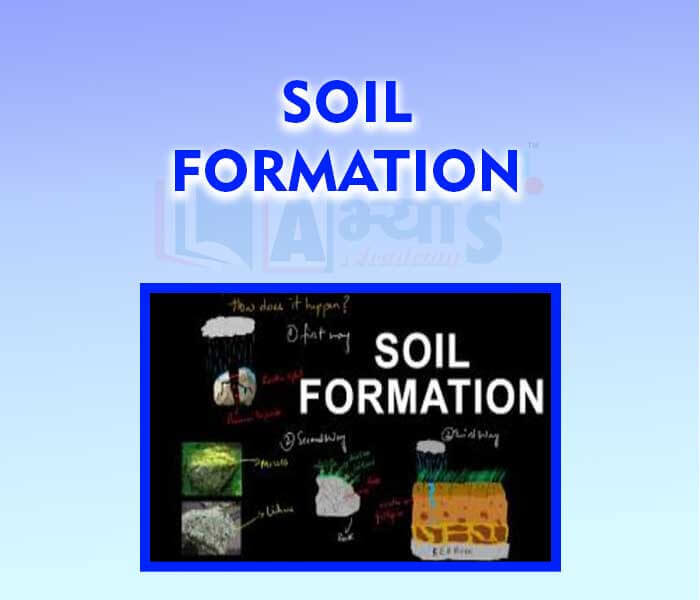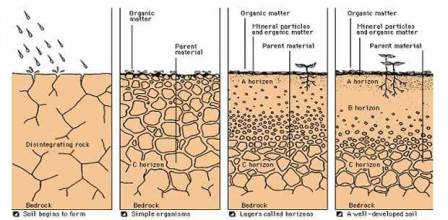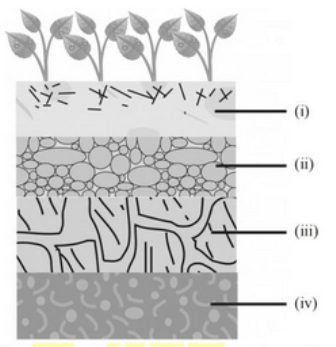Soil Formation







Soil Formation
Formation of soil: The fine particles of soil are formed mainly by the breaking down of larger rocks by the action of wind, moving water (rain and river water), snow and sun. This process is called weathering. Dead animals and plants decompose and add valuable minerals to the soil. This makes the soil fertile. Microbes play an important role in maintaining the fertility of soil. The soil which we see today has been formed over thousands of years. So, we should conserve this valuable resource.
Factors affecting soil formation
There are a number of factors which affect soil formation, namely, climate, characteristics of the parent rock, and slope of land.
· Climate: Climatic factors or weathering forces such as temperature, rain, wind, etc., play an important role in loosening and breaking up rocks (physical weathering).
· Water in rock crevices expands when it freezes, hence, increasing the pressure and causing the rocks to crack. Rocks are also worn down by wind.
Soil formation is fastest in hot, moist climates and slowest in cold, dry climates.
In the warm and wet tropics, bacterial activity is high. As a result, soil in these areas have a rich content of humus.
On the other hand, desert regions have very little vegetation and animal life, and so limited decaying material is available for the soil.
The lack of rainfall leads to the formation of coarse-textured soil in dry and arid regions. In areas that experience severe winter, bacterial activity is very slow causing dead plant and animal matter to build up.
Therefore, soil in such places forms very slowly. Thus, the rate of soil formation and the type of soil formed depends on the climate of a place.
2.Characteristics of the parent rock: The composition of the parent rock also determines the kind of soil formed. For example, if the parent rock is rich in calcium, the soil formed by its weathering would be rich in calcium, too.
3.Slope of land: The physical features of a place play an important role in the formation of soil. Hilly areas generally have a thin layer of soil because running water and wind tend to carry the soil down the slope.
On flat plains, soil remains relatively undisturbed leading to the formation of a thick layer.

| |||||
| Right Option : D | |||||
| View Explanation | |||||
Under ideal climatic conditions how many cms of soil is developed? | |||
| Right Option : A | |||
| View Explanation | |||
_____________________ is usually present as a thin film around the soil particles. | |||
| Right Option : C | |||
| View Explanation | |||
Students / Parents Reviews [10]
Being a parent, I saw my daughter improvement in her studies by seeing a good result in all day to day compititive exam TMO, NSO, IEO etc and as well as studies. I have got a fruitful result from my daughter.

Prisha Gupta
8thAbhyas Methodology is very good. It is based on according to student and each child manages accordingly to its properly. Methodology has improved the abilities of students to shine them in future.

Manish Kumar
10thMy experience was very good with Abhyas academy. I am studying here from 6th class and I am satisfied by its results in my life. I improved a lot here ahead of school syllabus.

Ayan Ghosh
8thA marvelous experience with Abhyas. I am glad to share that my ward has achieved more than enough at the Ambala ABHYAS centre. Years have passed on and more and more he has gained. May the centre flourish and develop day by day by the grace of God.

Archit Segal
7thMy experience with Abhyas is very good. I have learnt many things here like vedic maths and reasoning also. Teachers here first take our doubts and then there are assignments to verify our weak points.

Shivam Rana
7thAbhyas is a complete education Institute. Here extreme care is taken by teacher with the help of regular exam. Extra classes also conducted by the institute, if the student is weak.

Om Umang
10thIt was good as the experience because as we had come here we had been improved in a such envirnment created here.Extra is taught which is beneficial for future.

Eshan Arora
8thAbout Abhyas metholodology the teachers are very nice and hardworking toward students.The Centre Head Mrs Anu Sethi is also a brilliant teacher.Abhyas has taught me how to overcome problems and has always taken my doubts and suppoeted me.

Shreya Shrivastava
8thIt was a good experience with Abhyas Academy. I even faced problems in starting but slowly and steadily overcomed. Especially reasoning classes helped me a lot.

Cheshta
10thI have spent a wonderful time in Abhyas academy. It has made my reasoning more apt, English more stronger and Maths an interesting subject for me. It has given me a habbit of self studying

